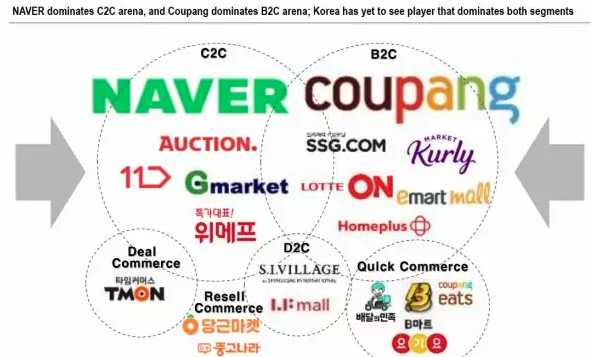
The Korean e-commerce market, once experiencing rapid growth, is now facing a slowdown. This shift is due to the end of the pandemic and a return to offline shopping, leading to weakened growth drivers in e-commerce.
Companies are responding with strategies like mergers and acquisitions, with major players restructuring the competitive landscape. Additionally, the focus is on enhancing customer loyalty through subscription services and improving payment systems.
The market is also seeing intense competition in logistics, with significant investments in efficient, technologically advanced systems.
The Evolution of Korean E-Commerce (Socialcommerce)

Today, I want to talk about a really interesting topic. It’s all about social commerce. Social commerce refers to a new shopping method that grows in tandem with social networking services (SNS). An intriguing fact is that back in 2005, Yahoo defined it as a way for consumers to rate products and share their shopping carts and related information. Social commerce mainly features product review boards and integration with SNS, and it has grown tremendously with the activation of SNS. In 2008, with the emergence of Groupon, the social commerce market started to take shape. Astonishingly, by 2014, the revenue rose to $3.191 billion!
In South Korea, the entry of Coupang, TMON, and Wemakeprice into the market in 2010 brought a fresh wind to the e-commerce market. Communication platforms like Twitter and Facebook played a significant role in sharing and spreading social commerce event products. For instance, Coupang drew huge popularity by selling Homeplus gift vouchers at half price, TMON created a boom in social commerce by selling Krispy Kreme doughnuts at half price, and Wemakeprice hit a jackpot by offering a 60% discount on Samsung Everland’s free-pass tickets. This sales method attracted customer interest, and consumers were more than willing to open their wallets. Especially for small business owners and street food vendors who struggled with publicity, the influx of customers with coupons was a boon.
The foundation of this growth is ‘curation.’ It’s a strategy of selecting and offering excellent services or products preferred by customers at great prices. However, with changes in the market and customer environment, social commerce companies also had to evolve. They moved away from the limited product sales approach to a direction where they could sell a wider range of products. This shift is a vital lesson for companies that need to innovate and face new challenges in response to market and customer demands.
Isn’t it a fascinating topic? The world of social commerce continues to develop and change. I’m really excited to see what it will look like in the future! What are your thoughts? Now, let’s talk about the Korean e-commerce in 2023.
Korean E-Commerce in 2023, 2024
In the unprecedented situation of the COVID-19 pandemic, marketers have faced the challenging task of conducting effective marketing while reducing budgets. Despite the downturn in the economy and declining sales, marketing remains a continuous necessity. Looking ahead to 2023 and 2024, marketing is still essential, and there are several trends prepared for this era.
Phygital
Now, offline stores and online channels are merging into one with phygital marketing becoming the trend. Before COVID-19, utilizing various channels such as SNS, websites, and apps in omnichannel marketing was important. But now, the focus has shifted to combining digital technology to enhance both online and offline experiences.
Community-Centric Approach
As the relationship between companies and consumers shifts to be more consumer-centric, community marketing, where people voluntarily gather to share and communicate about common interests, is gaining attention. Instead of company-led communities, communities formed spontaneously by consumers are becoming the focus.
Short-Form Content
Short and concise short-form content is becoming popular. Several companies, including Ably, Dongwon F&B, and Binggrae, have achieved significant success with marketing using short-form content.
Micro-Personalization
The use of AI for personalized recommendation services has become important. Providing customized benefits based on individual tastes and preferences plays a big role in increasing customer loyalty.
First-Party Data
With the impending restrictions on third-party cookies, the importance of data collected from a company’s own channels has increased significantly. Many companies are adopting marketing strategies utilizing first-party data.
Thus, the role of marketers is undergoing significant changes. Strategies that maximize effects with minimal costs, utilizing AI and automation, have become crucial. It’s a time that calls for thorough customer analysis and precise personalized marketing, turning crises into opportunities. What are your thoughts on this?
In Conclusion
In conclusion, the Korean e-commerce landscape, marked by its dynamic and evolving nature, has undergone significant changes, especially in the wake of the COVID-19 pandemic. The initial rapid growth of e-commerce experienced a slowdown, shifting the focus of companies towards strategies like mergers, acquisitions, and restructuring to stay competitive. The advent of social commerce, with its integration of social networking services and e-commerce, has played a crucial role in shaping this market, contributing significantly to its growth and transformation.
As we look towards 2023 and 2024, Korean e-commerce faces new challenges and opportunities. The blend of physical and digital experiences, known as phygital marketing, is becoming more prevalent, indicating a shift in marketing strategies. The rise of community-centric approaches, the popularity of short-form content, the importance of micro-personalization using AI, and the reliance on first-party data highlight the evolving nature of consumer engagement and marketing tactics.
These trends underscore the necessity for marketers to adapt and innovate continually. By focusing on customer-centric strategies, embracing technological advancements, and leveraging data effectively, Korean e-commerce can navigate the changing landscape and turn challenges into opportunities for growth and success. As we witness these transformations, it’s clear that the Korean e-commerce market will continue to be a significant player in the global digital economy.











